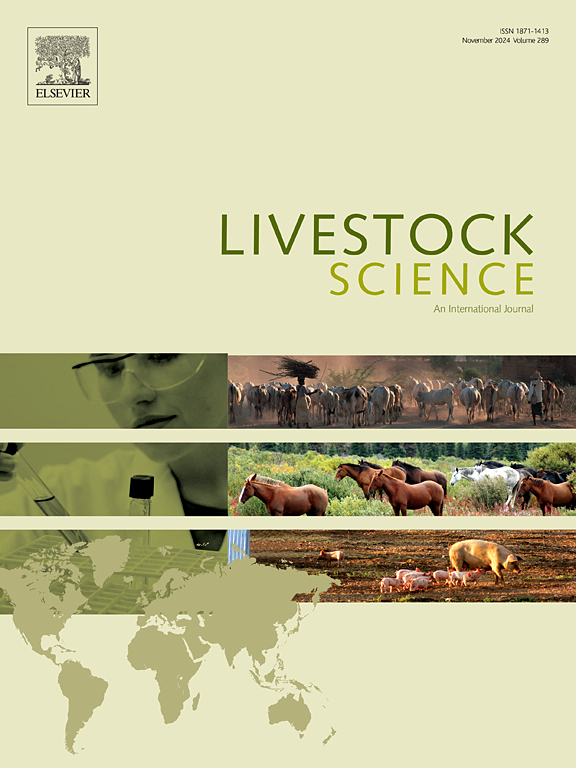不同精氨酸/赖氨酸比例和添加胍乙酸对肉鸡生长性能、胴体特性和乳腺肌病的影响
IF 1.8
3区 农林科学
Q2 AGRICULTURE, DAIRY & ANIMAL SCIENCE
引用次数: 0
摘要
本试验旨在评价提高肉仔鸡可消化精氨酸与赖氨酸之比(试验1)对肉仔鸡生长性能、胴体组成和乳腺肌病的影响,并评价胍基乙酸(GAA)(试验2)节约精氨酸的作用。试验(Exp) 1将672只雄性罗斯308鸟分为4个试验组,分4期饲喂。对照处理在发菜、生长ⅰ、生长ⅱ和育肥猪饲粮中精赖氨酸/赖氨酸比值(精赖氨酸∶赖氨酸)分别为1.06、1.06、1.07和1.08;其余3个试验组在对照组饲粮中添加l -精氨酸,各饲喂期精氨酸:赖氨酸比值分别为1.15、1.25和1.35。试验2,采用相同的饲养方案,将504只雄性罗斯308鸡分为3个试验组:对照组饲粮的精赖氨酸∶赖氨酸比为1.05,另外2个处理饲粮的精赖氨酸当量分别为77% (GAA77)和149% (GAA149),分别添加0.6 g/kg GAA。在试验1中,随着精赖氨酸∶赖氨酸比的增加,在0 ~ 10和0 ~ 20 d的累积阶段,体重(BW)、体重增重(BWG)和饲料系数(FCR)均呈二次曲线变化(P均≤0.03)。在这3个阶段,以最高的精赖氨酸∶赖氨酸比(1.35)获得最高的体重、体增重和最佳的饲料效率。后一种效应在0-30天和0-44天没有观察到。在实验2中,GAA替代Arg对生产性能没有影响(P >;阶段0-20 0.13),0 30和0-44 d,但GAA77货物受损而控制阶段清廉d (P = 0.05)。骨架特征,只有乳房产量增加在两个棉酚组相比,控制在35 d (P = 0.01),肉和乳房发红(a *) (P = 0.01),减少GAA77场骗局相比皮肤划痕,乳房肌肉疾病,垃圾分数和脚垫皮炎没有受到饮食治疗的2经验值。综上所述,在不影响乳腺肌病发病率的情况下,将饲料中精赖氨酸∶赖氨酸比值提高至1.35对0 ~ 20日龄肉鸡生长性能有积极影响。饲粮中添加GAA可替代77%的精氨酸,且不影响肉鸡生产性能参数。本文章由计算机程序翻译,如有差异,请以英文原文为准。
Effect of different arginine-to-lysine ratios and guanidinoacetic acid supplementation on the growth performance, carcass characteristics and breast myopathies in broiler chickens
The aim of the study was to evaluate the effect of increasing the digestible arginine-to-lysine ratio (dig Arg:Lys) (Experiment 1), and to evaluate the Arg sparing effect of guanidinoacetic acid (GAA) (Experiment 2) on growth performance, carcass composition and breast myopathies in broiler chickens. In experiment (Exp) 1, a total of 672 male Ross 308 birds were assigned to 4 experimental groups provided in a 4-phase feeding scheme. The Control treatment had a dig Arg to Lys ratio (Arg:Lys) of 1.06, 1.06, 1.07 and 1.08 in starter, grower I, grower II and finisher diets, respectively; the other three experimental treatments had a dig Arg:Lys ratio of 1.15, 1.25 and 1.35 across all feeding phases by adding L-Arg to Control diets. In Exp 2, 504 male Ross 308 birds were fed using the same feeding scheme and assigned to 3 experimental groups: the Control diet had a dig Arg:Lys ratio of 1.05, and the other two treatments were supplemented with 0.6 g/kg GAA using two different dig Arg equivalency: 77% (GAA77) or 149% (GAA149). In Exp 1, body weight (BW), BW gain (BWG) and feed conversion ratio (FCR) were affected in a quadratic fashion (P ≤ 0.03 for all) at cumulative phases 0-10 and 0-20 d when increasing the dig Arg:Lys ratio. In these phases, the highest BW, BWG and best FCR were obtained with the highest dig Arg:Lys ratio (1.35). The latter effects were not observed for the phases 0-30 and 0-44 d. In Exp 2, the replacement of Arg by GAA did not affect the productive performance (P > 0.13) in the phases 0-20, 0-30 and 0-44 d, but GAA77 impaired FCR compared to control (P = 0.05) in phase 0-10 d. For carcass traits, only breast yield was increased in both GAA groups compared to Control (P = 0.01) at 35 d, and breast meat redness (a*) was decreased (P = 0.01) with GAA77 compared to CON. Skin scratches, breast myopathies, litter score and foot pad dermatitis were not affected by dietary treatments in any of the 2 Exps. In conclusion, increasing the dig Arg:Lys ratio to 1.35 has a positive effect on growth performance from 0-20 d of age without affecting breast myopathies incidence. Dietary supplementation of GAA could replace 77% of Arg without affecting performance parameters in broilers.
求助全文
通过发布文献求助,成功后即可免费获取论文全文。
去求助
来源期刊

Livestock Science
农林科学-奶制品与动物科学
CiteScore
4.30
自引率
5.60%
发文量
237
审稿时长
3 months
期刊介绍:
Livestock Science promotes the sound development of the livestock sector by publishing original, peer-reviewed research and review articles covering all aspects of this broad field. The journal welcomes submissions on the avant-garde areas of animal genetics, breeding, growth, reproduction, nutrition, physiology, and behaviour in addition to genetic resources, welfare, ethics, health, management and production systems. The high-quality content of this journal reflects the truly international nature of this broad area of research.
 求助内容:
求助内容: 应助结果提醒方式:
应助结果提醒方式:


